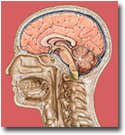New Mechanism Controlling Neuronal Migration Discovered
 The molecular machinery that helps brain cells migrate to their correct place in the developing brain has been identified by scientists at St. Jude Children's Research Hospital. The molecular machinery that helps brain cells migrate to their correct place in the developing brain has been identified by scientists at St. Jude Children's Research Hospital.
The finding offers new insight into the forces that drive brain organization in developing fetuses and children during their first years.
Disruption of this brain-patterning machinery can cause epilepsy and mental retardation and understanding its function could give new insight into such disorders.
Led by David Solecki, Ph.D., an assistant member in the St. Jude Department of Developmental Neurobiology, the researchers published their findings in the July 16 issue of the journal Neuron.
In the experiments, the researchers sought to understand the biological machinery powering a process called glial-guided neuronal migration. Glial cells in the brain support and guide neurons, which make up the brain's wiring. During brain development, neurons are born in germinal zones at some distance from where they must ultimately land in order to form brain structures and integrate into the brain's circuitry.
"Glial cells produce very thin fibers, and neurons in essence walk a tightrope along these fibers in moving from these germinal zones to their final position," Solecki said. In earlier work, Solecki and his colleagues identified a control molecule called Par6 alpha that regulates this migration.
Other researchers had produced evidence that a molecular motor called Myosin II might power the migration. Myosins are proteins that use chemical energy to create contractions by moving along filamental proteins called actins-like a train moves along a railroad track.
The researchers used a technique of microscopic time-lapse imaging to establish that Myosin II and actin made up the machinery of neuronal migration. Working with cultures of migrating neurons, the investigators used fluorescent dyes to label Myosin II and actin proteins, as well as key cell structures.
The scientists then illuminated the cultures with rapid-fire pulses of laser light measured in thousandths of a second, taking an image with each flash. The result was a series of micromovies that revealed how the Myosin II and actin proteins and cell structures behaved during migration.
These micromovies showed that the Myosin II-actin machinery powers neuronal migration. As part of a step-wise migration process, the machinery pulls the internal cell structures of the neuron forward during migration to allow those structures to build the scaffolding that enables the neuron to move the main cell body forward. The researchers demonstrated that both Myosin II and actin are necessary for the process, because they could completely shut it down by using drugs that inhibited either molecule.
Source: St. Jude Children's Research Hospital
|